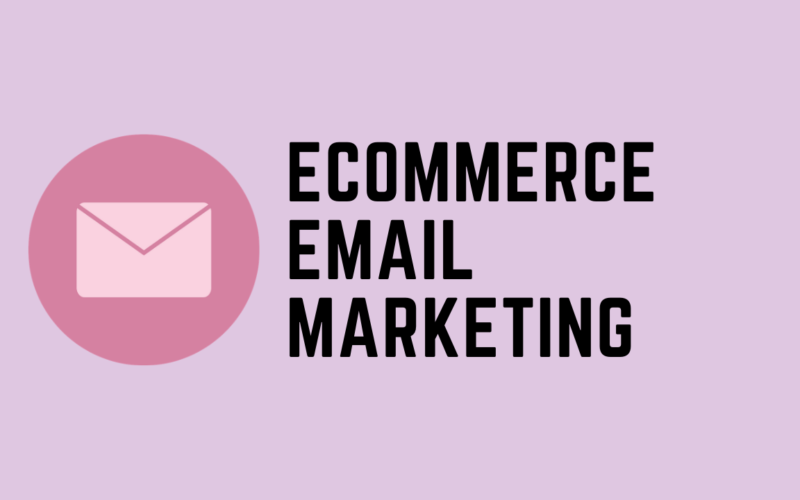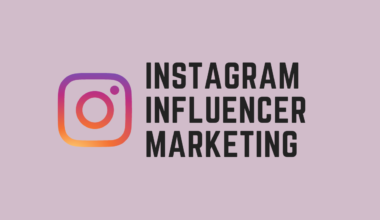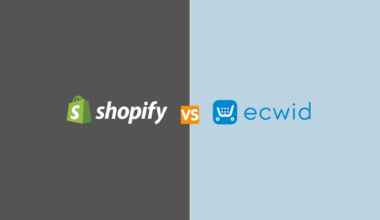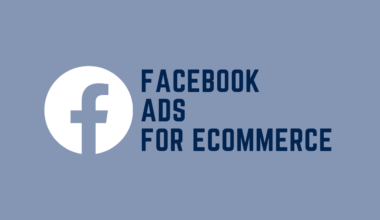eCommerce email marketing is still one of the most effective tools for customer acquisition in 2021. Both B2B and B2C businesses use eCommerce email marketing to generate a large portion of their revenue.
However, if you don’t have the right strategy, your emails will end up getting ignored or in your prospective customer’s trash.

The traditional email marketing strategy that focuses on sending non-targeted emails to a huge number of people is not going to cut it anymore. Around 43% of people want brands to send them emails less often. You don’t have to be a part of that statistic. Here are some ways you can make your eCommerce email marketing strategy stand out from the crowd.
Table of Contents
Importance of eCommerce Email Marketing
eCommerce is getting more competitive year after year. With 20 million eCommerce websites online, it’s tough to snag the attention of your prospective customers. And it’s even more tricky to get them to make a purchase decision. Many businesses turn to social media to drive more sales.
Undoubtedly, social media is an excellent way to expand your outreach and increase brand awareness. But you know what? There’s a catch, let me list that for you.
- Better Conversion Rate: Although it may not be the best channel for lead conversion, some stats by optin master reveals that emails get up to 6.05% conversion rate. On the other hand, social media is only capable of giving something like 1.9%.
- Effective Email Marketing: It bypasses the need to rank your content on search engines. Besides all of that, you also don’t have to engage in the constant battle against social media algorithms. With email marketing, you can reach your customers directly. And if you do it right, it can work wonders for your eCommerce business.
- Email Marketing is Relatively Cheaper: There is no need to pay for ads on social media. Once you have the leads even for once, you can reach out to your customers at a much cheaper price.
- Get the Control: In contrast, social media platforms might lose popularity. Or you might lose access to your account for some reason. The problem with social media is that you don’t own any of the platforms. The changes that happen to them are out of your control. If we talk about having an email list, things are in your control and won’t hurt your business.
- Email Marketing is Intentional: We get the email of our customer because they subscribed to the newsletter or wanted that freebie you set up. Or maybe, they engaged with you through LiveChat, chatbot, quiz, survey, etc. They showed interest in your brand and they might want to hear more too. That’s how email marketing gets you a highly targeted audience.
- Personalization: Here comes another key that brings sales on the table. With email, you have the opportunity to segment your audience and deliver highly targeted messages. In case the customers lose interest, you can go all personal and show them a message that would deliver the fact that you care!
An Ultimate eCommerce Email Marketing Strategy That Most Online Marketers Leverage
So far we’ve talked about how important it’s to nail your eCommerce email marketing strategy. In case you don’t know how to go about doing that, no worries because we’re going to walk you through the process of coming up with a killer strategy.
You can think of your email marketing strategy in three phases:
- Aiming at people that haven’t purchased from you yet
- Targeting those who have purchased to encourage more purchases
- Getting in touch with those that have lost interest and re-engaging them
Phase 1: Targeting Prospects
This phase starts when you get your prospective customer’s email. This is the beginning of your engagement with them.

Here are the types of email you need to send in this phase:
The Welcome Email
The first email you need to send is a welcome one. About 74% of people expect a welcome email after they subscribe. Welcome emails have very high engagement, don’t forget to bring your A-game to them.
To write the ideal welcome email, keep these pointers in mind:
- Make sure that your prospects know they’re receiving a welcome email in the subject line
- Greet them by saying Hi or Welcome
- Give an introduction to your brand and tell them why you’re special
- Tell them what they should expect from you and what’s next
- Make an offer like a coupon, discount, or giveaway
- Add links to your social media handles at the end
Welcome emails set the tone of your relationship with your prospect. And when they get an exciting offer in the very first email, they will look forward to future emails. So make sure to include an offer such as a coupon, discount, a welcome gift, etc.
The Nurture Emails
Keep in mind that eCommerce email marketing is about building a relationship with the consumer. After you send that welcome email, you can’t spam your prospect’s inbox with emails nudging them to buy your products. Instead of that, you should slowly lead them to buy something and make them feel good about the decision.
That’s why you should send nurture emails before sending promotional emails. In these emails, the primary goal is not to sell. The goal is to send enticing emails to educate the prospect about your brand. These emails can also be entertaining to enhance your prospect’s interest.
You can send 5-6 nurture emails to your prospect. Here are some pointers to keep in mind for making them:
- Tell your brand’s story to inspire prospects and spark an emotional response
- Send educational emails that highlight the features of your products
- Send generic but interesting educational emails about your products
- Lead prospects to other areas of your website like your blog
- Send an entertaining email e.g. with a video
- Include soft sells in all your nurture emails e.g. links to your product page at the end
The Promotional Emails
You’ve sent your nurture emails with soft sells. If your prospect hasn’t purchased by now, it’s time to go hard. The goal of these emails is to get the consumer to make the first purchase.
The best approach to make promotional emails work is personalization. For example, you can segment people according to the products they’ve visited on your website. After that, you can target them for those categories and products.
These emails should include offers to entice the prospect to make a purchase. Some examples of the offers you can use include:
- Free shipping on a certain amount
- Limited time offers that expire in a few days
- Discount that offers a percentage off
- A discount on spending a certain amount
- A gift for customers who spend a certain amount
This wraps up Phase 1. If your prospect has made a purchase, you can move to Phase 2. If they haven’t, skip ahead to Phase 3.
Phase 2: Engaging Customers
The hallmark of every successful business is loyal customers that keep purchasing from them. Your eCommerce email marketing strategy should focus on building that loyal customer base. And that’s exactly what we will be doing in Phase 2.

As an eCommerce business, it’s inefficient to concentrate most of your efforts on getting new customers. It’s 10 times cheaper to sell to an old customer than it is to acquire a new one. That’s another reason you should never neglect your existing customer base. Here are the types of emails you should send in this phase:
Transactional Emails
Transactional emails are the ones that you send after the customer that buys a product. For example, order confirmation or shipping details. These emails have a high proportion of engagement. And that’s your opportunity for cross-selling and up-selling.
You should also remind the customer about the benefits of doing business with you like free shipping and returns. Help them feel positive emotions at this stage. And they’re more likely to come back.
Cart Abandonment Emails
If you’ve been in eCommerce for a while, you know how frequent cart abandonment is. So take this into account in your eCommerce email marketing strategy.
Believe it or not, a cart abandonment email campaign is an effective way to recover some of that lost revenue. Here are some tips to send persuasive cart abandonment emails:
- First step is to send them a reminder that they’ve abandoned their cart
- Always include a link that takes them to complete their purchase
- Reinforce the benefits they get if they purchase from you
- Give a discount if the previous emails have no response
Online Retail Customer Emails
After your customer makes the first purchase, you can start an email campaign. These can compel them to make more purchases and become loyal customers. You can include these types of emails in your campaign:
- Congratulations on your first purchase
- Welcoming them to the community
- More nurture emails
- Promotions and discounts
- Product reviews and surveys
- Limited time offers
- Promotions for top customers
- Win back emails with promotions for customers that haven’t purchased in a while
- Rewards program for frequent customers
Phase 3: Re-engagement
Some prospects and customers are bound to lose interest and stop engaging. Does this mean that you should label them as a lost cause? Absolutely not. Re-engagement should be an important part of your eCommerce email marketing strategy.
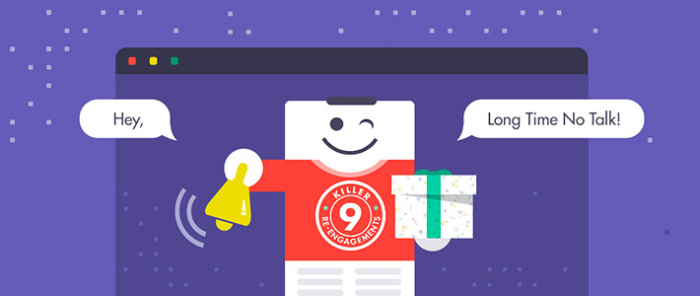
Here are some ways to send re-engagement emails:
- Select a specific time period of inactivity such as two months
- Send surveys to find out why they’re not making a purchase
- Offer bigger discounts
- Lead them to other website pages like your blog
Unfortunately, some people won’t engage. You can’t keep targeting them forever. You need to delete them from your email list.
3 Best eCommerce Email Marketing Software Out There
So you’re up to speed on the ultimate eCommerce email marketing strategy. The next thing you need is an eCommerce email marketing software. Here are 3 of the best software you can choose from:
MailChimp
MailChimp is the most popular software for eCommerce email marketing. And for good reason, it has 14 million customers including both small and medium eCommerce businesses.

Features of the platform
- Trigger-based messages
- Spam scores
- Reporting and analytics
- Previewing messages
- Geo-targeting
- Time-zone based delivery
- Third-party integration
Pros
- Easy to use
- Opt-in forms
- Beautiful design for templates
- Integration with third-party eCommerce platforms like Shopify and Magento
- Integration with social media
- Cost-effective pricing and free plan
Cons
- Create more templates if you don’t like the existing ones
- Interface can be clunky to some users
Constant Contact
Unlike MailChimp, eCommerce email marketing is just one tool that Constant Contact offers. From web building to logo making, you can use tools of various kinds.

Features of the platform
- Autoresponder
- Tracking coupons
- Contact management
- Tools for reporting
Pros
- Good deliverability
- Built-in email templates
- Easy to use
- Intuitive user interface
Cons
- No free plan and can be pricey
- Lack of options for segmentation
Klaviyo
Klaviyo is an expert software for capturing customer data. That’s why it’s a good option for eCommerce email marketing. For beautiful and ready-made eCommerce email marketing templates, you can try Constant Contact.

Features of the platform
- Analytics and reporting
- Statistics
- Complete automation
- Integration with third-party eCommerce platforms
Pros
- Excellent for personalization and segmentation
- Integration with eCommerce web designer and CRM platforms
- Cart abandonment sequences
Cons
- No free plan
- Can be pricey
The eCommerce email marketing software you select should depend on your needs. For example, MailChimp is an all-rounder but if you need more personalization, Klaviyo is a better option.
Great eCommerce Email Examples – Let’s Get Practical
To create a successful eCommerce email marketing campaign, you need to learn from the best. Let’s take a look at some amazing eCommerce email marketing examples.
Birthday Email
Everyone loves gifts on their birthday. And that’s why birthday emails generate 324% more revenue than other marketing emails. Here’s a birthday email from Sephora:
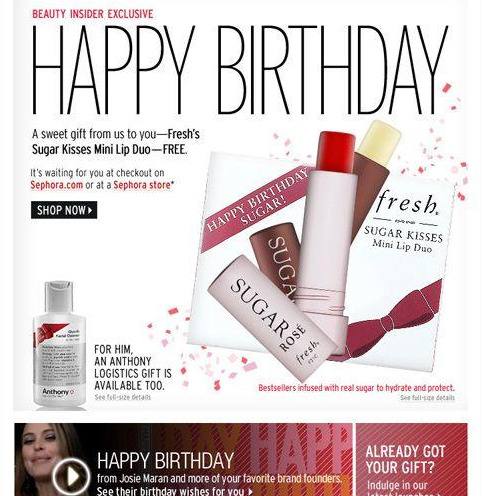
Cart Abandonment Email
So far we’ve learned that cart abandonment should be a crucial part of your eCommerce email marketing strategy. Fab nails it by creating scarcity, saying it’s limited and on sale:
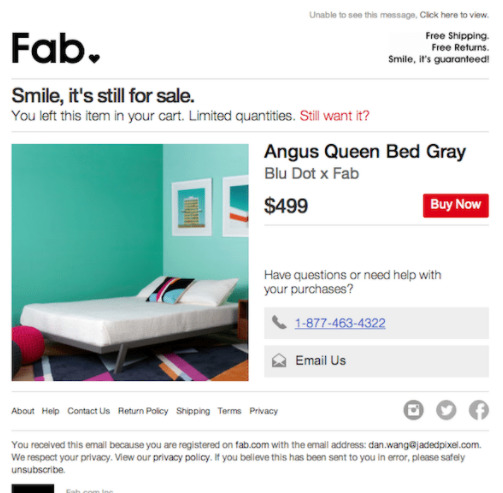
Welcome Email
Welcome emails have high engagement. Kate Spade leverages that by including a special treat in their welcome email.

Survey Email
Survey emails get you insights so that you can keep the customers engaged. Rapha kills two birds with one stone leveraging a survey and an offer a customer can’t refuse to take.
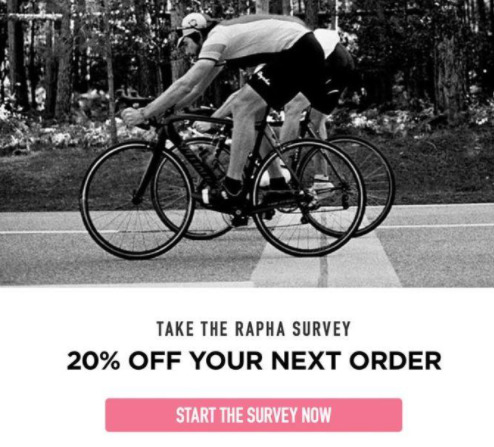
Re-engagement Email
eCommerce business owners should always be optimistic. Although Re-engagement doesn’t work all the time, sometimes it works well enough. Hire Vue’s re-engagement email is funny and may encourage a prospect to engage.
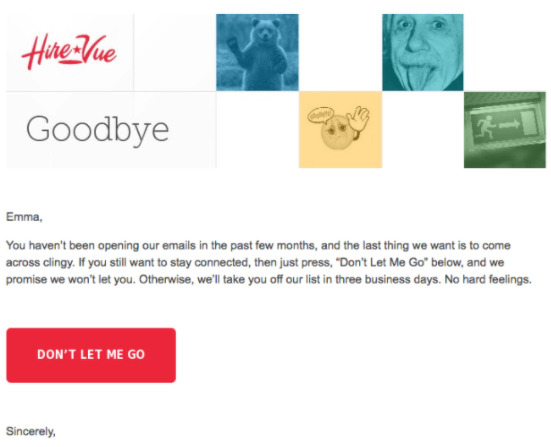
Last Minute Pro Tips for eCommerce Email Marketing
Before we wrap up our eCommerce email marketing guide, here are some more pro tips for you:
- Make sure your emails are mobile optimized
- Build your email around a single and effective call-to-action
- Do split-testing with email campaigns
- Create a referral program and give incentives for referring
- Always track and monitor your email campaigns for improvement in the future
